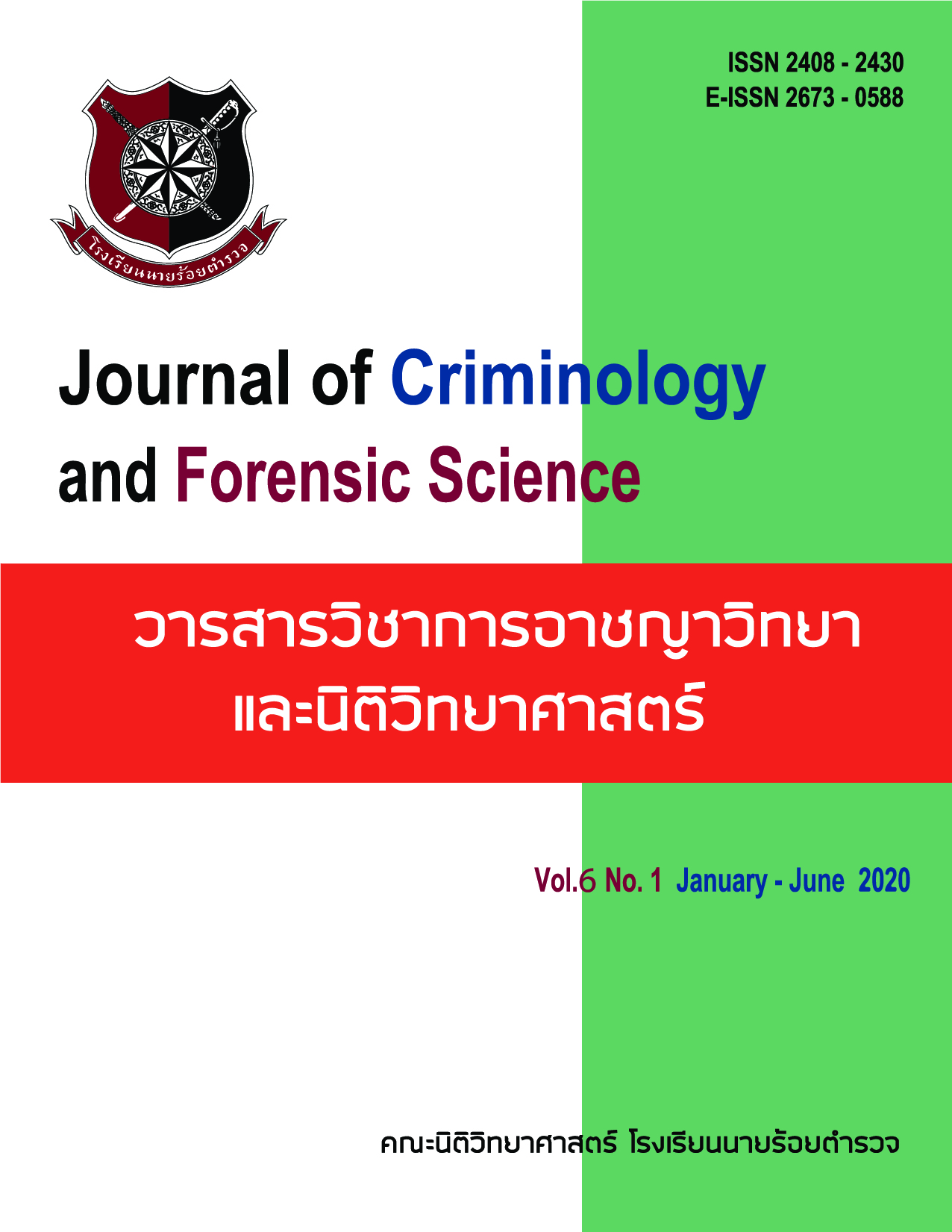Comparison of Ninhydrin Extraction Solvents from Latent Fingerprint Detectionon Various Paper Types
Main Article Content
Abstract
The objectives of this research are to study the appearance of latent fingerprints (LFP) on three types of papers including white copy paper, pink letter paper, and brown clasp envelope and to compare the quantity of Ninhydrin (2 grams, 5 grams, and 10 grams) used with five different solvents namely Acetone, Ethyl Acetate, Ethanol, Methanol, and Acetic Acid. The LFP quality, based on the number of minutiae and counted by an LFP expert was compared. Data were then statistically analyzed utilizing means, standard deviation, and two-way analysis of variance.
The results of this research showed that the LFPs detected on white copy paper, pink letter paper, and brown clasp envelope using 2 grams and 5 grams of Ninhydrin gave better quality than when using 10 grams of Ninhydrin. Among solvents, Acetone 100 ml and Ethyl acetate 100 ml developed the best LFP quality while Ethanol and Methanol showed the medium quality of LFP, whereas, a low quality of LFP was seen when applying Acetic Acid. When testing the hypothesis in both factors, it was found that types of solvents for Ninhydrin and types of papers for the detection of LFP affected the quality of the LFP with a significance level of 0.05
Article Details
เนื้อหาและข้อมูลในบทความที่ลงตีพิมพ์ใน วารสารวิชาการอาชญาวิทยาและนิติวิทยาศาสตร์ โรงเรียนนายร้อยตำรวจ ถิอว่าเป็นข้อคิดเห็นและความรั้บผิดชอบของผู้เขียนบทความโดยตรงซึ่งกองบรรณาธิการวารสาร ไม่จำเป็นต้องเห็นด้วยหรือรับผิดชอบใดๆ
บทความ ข้อมูล เนื้อหา รูปภาพ ฯลฯ ที่ได้รับการตีพิมพ์ใน วารสารวิชาการอาชญาวิทยาและนิติวิทยาศาสตร์ ถือว่าเป็นลิขสิทธิ์ของวารสาร วารสารวิชาการอาชญาวิทยาและนิติวิทยาศาสตร์ หากบุคคลหรือหน่วยงานใดต้องการนำทั้งหมดหรือส่วนหนึ่งส่วนใดไปเผยแพร่ต่อหรือเพื่อกระทำการใดๆ จะต้องได้รับอนุญาตเป็นลายลักษณ์อักษรจาก วารสารวิชาการอาชญาวิทยาและนิติวิทยาศาสตร์ ก่อนเท่านั้น
References
Chamsuwan, A. et al. (2003). Forensic Science 2 for Criminal Investigation. 4th Edition. Bangkok: G.B.P.Center. (In Thai).
Crown, D. A. (1969). The Development of Latent Fingerprints with Ninhydrin. The Journal of Criminal Law and Criminology, 60(2). pp. 258 - 264.
Jarurattanawibool, N. (2019). The Detection of Latent Fingerprints on the Knife Submerged in Water by Small Particle Reagent and Super Glue Method. Journal of Criminology and Forensic Science, 5(1), pp. 128 – 141.
Pensawat, D. (2015). Comparison of Fingerprint Development on Papers Using 5 –Methylthioninhydrin, Ninhydrin and 1, 2 – Indanedione. Master of Science Thesis, Silpakorn University, Nakhon Pathom. (In Thai).
Ruengdit, S. (2010). Appropriate Concentration of Ninhydrin for Latent Fingerprints Detection on Various Papers. Department of Biology, Faculty of Science, Mahidol University, Nakhon Pathom. (In Thai).
Seesuvan, P. (2018). Detection of Latent Fingerprints on Thermal Papers by the Method of Ninhydrin and Ninhydrin/PVP. Veridian E-Journal of Science and Technology Silpakorn University, 5(3), 73-93. (In Thai) .
Stoilovic, M. and Lennard, C. (2012). Fingerprint Detection & Enhancement, Incorporating Light Theory and General Forensic Applications of Optical Enhancement Techniques. 6th Edition. Canberra: Australian Federal Police.
Thamaphat, K. (2018). Innovative Device for Latent Fingerprints Development: Criminal Investigation Aspect. Retrieved June 10, 2019. from http://www.scir.rmutk.ac.th/files/users/202/project/1502182203.pdf.
Theangtheantham, S. (2013). Development of Latent Fingerprints on Objects Submerged in Natural Water by Using Small Particle Reagent and Black Powder. Master of Science Thesis, Silpakorn University, Nakhon Pathom. (In Thai).
Wertheim, P. A. (2015). Ninhydrin: Basic to Advanced. Retrieved January 19, 2019. from http://www.iowaiai.org/ninhydrin-basic-to-advanced.


